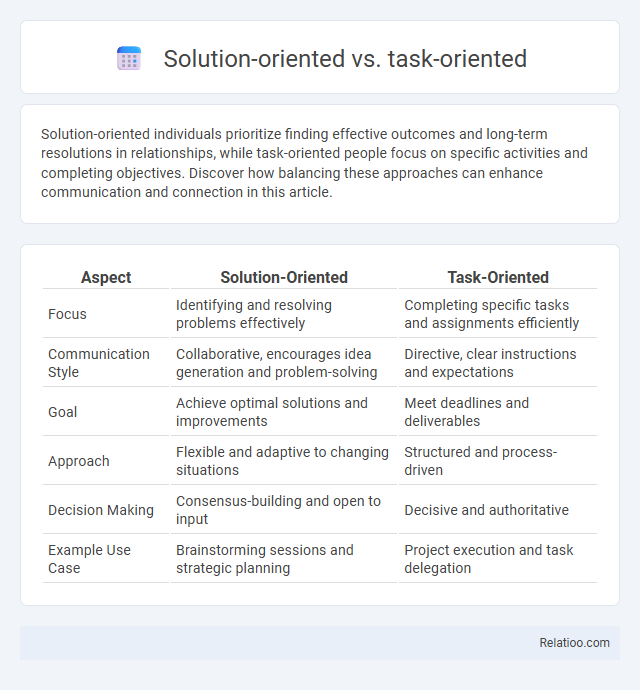Solution-oriented individuals prioritize finding effective outcomes and long-term resolutions in relationships, while task-oriented people focus on specific activities and completing objectives. Discover how balancing these approaches can enhance communication and connection in this article.
Table of Comparison
| Aspect | Solution-Oriented | Task-Oriented |
|---|---|---|
| Focus | Identifying and resolving problems effectively | Completing specific tasks and assignments efficiently |
| Communication Style | Collaborative, encourages idea generation and problem-solving | Directive, clear instructions and expectations |
| Goal | Achieve optimal solutions and improvements | Meet deadlines and deliverables |
| Approach | Flexible and adaptive to changing situations | Structured and process-driven |
| Decision Making | Consensus-building and open to input | Decisive and authoritative |
| Example Use Case | Brainstorming sessions and strategic planning | Project execution and task delegation |
Understanding Solution-Oriented and Task-Oriented Approaches
Solution-oriented approaches prioritize identifying and implementing effective strategies to resolve problems by focusing on desired outcomes and long-term impacts. Task-oriented methods emphasize completing specific activities or steps according to predefined procedures, often concentrating on efficiency and accuracy within the task scope. Understanding the distinction between solution-oriented and task-oriented approaches enables better decision-making by aligning problem-solving techniques with organizational goals and project requirements.
Key Differences Between Solution-Oriented and Task-Oriented Mindsets
Solution-oriented mindsets prioritize finding innovative outcomes and long-term improvements by analyzing challenges holistically, whereas task-oriented mindsets emphasize completing specific assignments efficiently with a focus on process and immediate results. Key differences include solution-oriented individuals seeking adaptability and creativity to address root causes, while task-oriented individuals rely on structured routines and measurable milestones to ensure productivity. Understanding these distinctions aids in selecting the appropriate approach for dynamic problem-solving versus operational consistency.
When to Use a Solution-Oriented Approach
A solution-oriented approach excels in complex, dynamic situations requiring innovation and long-term problem-solving, prioritizing holistic understanding over mere task completion. It is ideal when challenges demand creativity, collaboration, and adaptive strategies rather than repetitive, predefined actions typical of task-oriented methods. Deploying solution-oriented strategies enhances resilience and promotes sustainable outcomes in environments marked by uncertainty and evolving demands.
Benefits of Being Solution-Oriented
Being solution-oriented enhances problem-solving efficiency by prioritizing actionable strategies over mere task completion, leading to faster resolution and improved outcomes. This approach fosters adaptability and creative thinking, enabling individuals and teams to overcome obstacles and drive innovation. Emphasizing solutions also cultivates a proactive mindset, boosting productivity and overall organizational effectiveness.
The Strengths of Task-Oriented Strategies
Task-oriented strategies excel in organizing work through clear, structured processes that enhance productivity and ensure consistent task completion. Their focus on detailed planning and step-by-step execution reduces errors and increases efficiency by breaking down complex projects into manageable tasks. This methodical approach facilitates resource allocation and deadline adherence, making it ideal for projects requiring precision and routine.
Common Pitfalls of Task-Only Focus
Task-only focus often leads to overlooking underlying problems and failing to develop sustainable solutions, resulting in short-term fixes rather than long-term improvements. Employees fixate on completing assigned duties, which can cause missed opportunities for innovation and limit adaptability in dynamic environments. Emphasizing solution-oriented approaches cultivates proactive problem-solving skills and drives organizational growth beyond mere task completion.
Integrating Solution and Task Orientation in the Workplace
Integrating solution-oriented and task-oriented approaches in the workplace enhances productivity by combining problem-solving creativity with structured task execution. Employees who balance solution orientation's innovation and adaptability with task orientation's detail focus and efficiency drive better project outcomes and team collaboration. Leveraging both mindsets fosters a dynamic work environment where challenges are addressed proactively while maintaining consistent progress toward goals.
Case Studies: Solution-Oriented vs Task-Oriented Outcomes
Case studies comparing solution-oriented and task-oriented approaches reveal distinct outcome patterns, with solution-oriented strategies often leading to innovative problem resolution and sustained improvements, while task-oriented methods emphasize the efficient completion of predefined objectives. Organizations applying solution-oriented frameworks demonstrate higher adaptability and long-term success in complex project environments. Empirical data highlights that integrating creative problem-solving with task management optimizes overall performance and stakeholder satisfaction.
Developing a Balanced Problem-Solving Skillset
Developing a balanced problem-solving skillset requires integrating solution-oriented approaches, which emphasize identifying effective outcomes, with task-oriented methods that focus on executing specific actions efficiently. Emphasizing adaptability, individuals refine their ability to both conceptualize innovative solutions and systematically complete necessary tasks, enhancing overall productivity and decision-making. Mastery of this balance supports dynamic responses to complex challenges across diverse professional environments.
Choosing the Right Approach for Your Goals
Choosing between solution-oriented and task-oriented approaches depends on your goals and the nature of the challenge. Solution-oriented strategies prioritize identifying innovative methods to overcome obstacles and drive long-term success, while task-oriented methods emphasize completing specific actions efficiently to meet immediate deadlines. Aligning your approach with desired outcomes ensures focused efforts, boosting productivity and overall effectiveness.

Infographic: Solution-oriented vs Task-oriented
 relatioo.com
relatioo.com